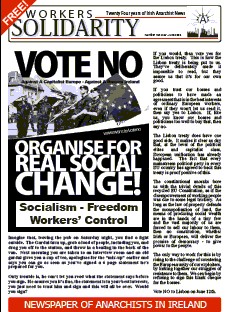The 1st of May as International Workers’ Day dates back to the struggle for the 8-hour working day in the USA. In 1886 the American Federation of Labour declared that after May 1st, “8 hours shall constitute a legal days labour”. Between that declaration and May 1st workers all around the United States went on strike to make their employers agree to a shorter work day.
A general strike started in Chicago on May 1st, with 25,000 workers striking. After two days the strikers had doubled in numbers. At this stage scabs had entered the scene, causing fights between them and the striking workers. The police moved in and killed six workers. In protest at this a public meeting was held on Haymarket Square in Chicago on May 4th. Once again the police intervened by attacking the peaceful protest, and this led to a bomb being thrown (by a person who was never identified). Seven policemen and four workers were killed.
After this the ruling class used the bomb as an excuse to arrest those believed to be the eight most active anarchist trade unionists in the city and accused them of being responsible for the bomb and the riot.
Most of the arrested anarchists had not even been present, which was acknowledged by the prosecutor and there was no evidence that any of them threw the bomb. Despite this the court was determined to find the anarchists guilty and in the end it came up with the argument that the arrested anarchists had “indirectly” killed the cops on Haymarket Square by agitating for a labour uprising at meetings and through newspaper articles This was enough to rule them guilty.
The outcome of the trial was seven death sentences and one of 15 years in prison. Due to an international campaign, two of the anarchists had their sentences commuted from death by hanging to life in prison, but four were hanged and one committed suicide. These five are today known as the Chicago Martyrs.
On the initiative of the American Federation of Labour, the worldwide trade union and socialist movement declared May 1st as International Workers’ Day in honour of the Chicago dead and the struggle for the eight hour day. The first time the day was marked in the USA was in 1890.
The eight hour day began to be achieved in the USA after often bitter struggles. In 1938 it became part of the government’s New Deal and was made a legal days work.There are several things to be said about the history of International Workers’ Day. One is that the trial shows how capitalism is prepared to disobey its own rules of justice when it comes to protecting the interests of the rich and powerful.
Another is that nothing comes from nothing. Workers of the world would have no rights, if they hadn’t been fought for. In Ireland the eight hour workday is upheld by the unions and not the law. Employers can, legally, force you to work up to thirteen hours a day or 48 hours a week. Attacks on our standard of living are part and parcel of life under capitalism.
So long as other people profit from our labour, they will try to make us work harder and longer for less money. Until the day we end the rule of the bosses, we have to stay organised to keep the rights we have gained and win more.
First published on indymedia.ie

This article is from Workers Solidarity 103, May - June 2008
PDF of the Southern edition of WS103
PDF of northern edition of WS103

